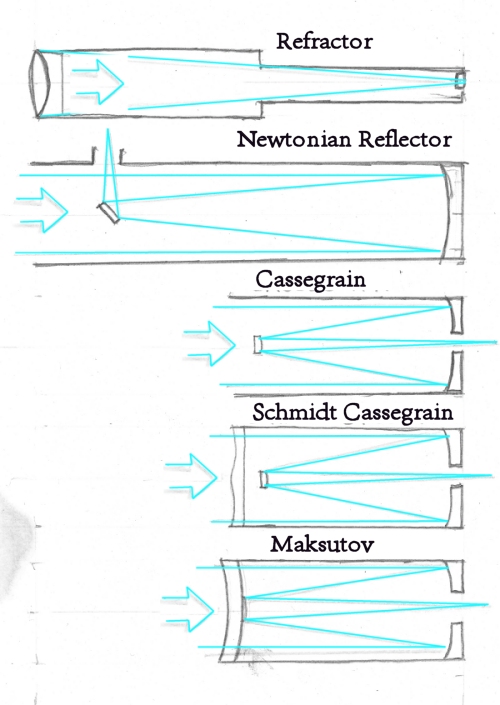The Main Five Types of Telescopes
There are different types of telescopes available on the market depending on different features. Here we will discuss the tube assembly and light path of five types of telescopes.

Fig 1: tube assembly and light path of five types of telescopes
The image shows how they are different in assembly and lightpaths and they have different reasons for it. Moreover, all of them have a plenty of pros and cons which we are going to review it.
The Refractor telescope
This is one of the oldest models of telescopes and widely used. These design is seen mostly in the beginner scopes.They have an aperture lens and an eyepiece at the two ends. The aperture lens is sometimes called sandwich lenses.
Pros:
- It has fantastic revolving power
- The performance is satisfying even in inferior conditions
- Light never reflects in this tube assembly
- The optical alignment is nearly permanent- so you do not need to have headache on maintenance.
- The design and eyepiece is simple.
- It has long focal ratios that means longer focus.
Cons:
- The cost is higher than the reflector telescopes
- It faces chromatic aberration which causes change of color of the image.
The Newtonian Reflector
The reflector telescopes designed by Newton do not use lens, it uses mirror. A small flat mirror is used herre to direct the light to the eyepiece.
Pros:
- It has better light collection ability than the refractors as it has large mirrors.
- No chromatic aberration
- The cost is relatively low
Cons:
- Optical quality is sometimes disappointing and not very good for astrophotography.
- You have to collimate it before use and take of mirror cleaning timely.
- The tube is open, so you have to take care of the dusts and humidity.
- A little bit bulky and heavier.
Cassegrain
Cassegrain telescopes are unique as they use a mirror, but with a hole at the center. It can direct the light towards the back. The secondary mirror is a concave mirror, i.e. not flat like newtonian. It enhances the focal length and in turn provides better performance. Cassegrain telescopes are not widely available like the other two mentioned before. Schmidt Cassegrain and Maksutov telescopes are made based on this design and they are also very popular.
Catadioptric Telescopes
Catadioptric Telescopes are designed using mirrors and lenses both. There are two types of Catadioptric scopes.
Schmidt Cassegrain
This design uses a spherical mirror. Most importantly it ha a curved and thin piece of glass at the very front that helps to correct the output of spherical mirror.
Pros:
- This is great for sky observation and astrophotography.
- The optics can be folded that makes it lighter and shorter.
- It has a focal reducer so that you can use it in versatile purpose.
Cons:
- It is expensive
- Views are narrower and exposures are longer
- The contrast is less and sometimes need collimation
Maksutov Cassegrain
This design also includes the correcting glass at the front. The secondary mirror is basically an aluminized circle attached with the glass.
Pros:
- Good for planetary views.
- Optics are folded
- More affordable
Cons:
- Only one focal length
- High quality and expensive
- Long focal ratio
What Types of Telescopes are Easiest to Use?
The easiest type of telescope to use is the Dobsonian. The ease of use is a result of its simple altazimuth mount and intuitive Newtonian optical system, which allows for quick and straightforward pointing and viewing. While Newtonian telescopes are generally easy to use, the Dobsonian’s overall design is tailored for quick setup and observation, making it a favorite for beginners.
Refractor telescopes are also renowned for their ease of use due to the straightforward optical path and minimal maintenance. When it comes to planetary observation, refractor telescopes provide sharp and high-contrast images, giving planets a detailed appearance.
What Types of Telescopes are Better for Viewing Planets?
Refractor telescopes are considered the best for viewing planets. Refractors, with their lens-based design, offer sharp, high-contrast images ideal for discerning intricate planetary details. This clarity and the overall simplicity of design makes them excellent for observing features on planets such as Jupiter’s cloud bands or Saturn’s rings.
On the other hand, the Maksutov-Cassegrain, with its combination of mirrors and lenses, provides an especially clear and focused view of planets, ensuring that brighter planets, like Venus and Mars are vividly rendered. While many telescopes bring their own advantages to the table, refractors and Maksutov-Cassegrains provide the purest and most detailed views of our solar system.
What is the Best Type of Telescope?
The best type of telescope will depend on the observer’s goals and preferences, but the optimal design is evaluated based on specific criteria, including their usage, performance, quality, and popularity within the astronomy community.
Novice astronomers often gravitate towards instruments that offer user-friendliness and simplicity. In contrast, seasoned observers search for telescopes that feature advanced capabilities and can be adapted for specialized tasks, like astrophotography. Thus, the finest telescopes for observational astronomy strike a balance between magnification power, aperture, and intuitive design.
A telescope’s longevity and resilience serve as critical quality indicators. This encompasses the robustness of the tube, the mount’s reliability, and the durability of its various parts. The best telescopes should withstand regular use, fend off the elements, and retain its internal precision over time.
